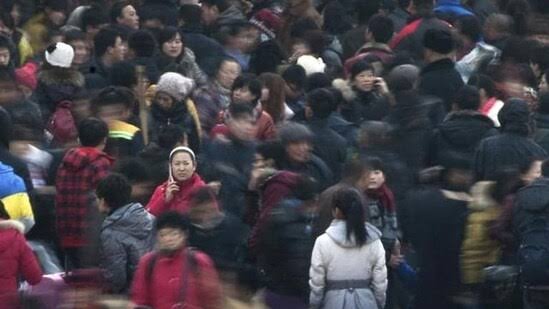China’s Population Declines for Second Consecutive Year, Accelerating Economic Concerns: 2024

China’s population experienced a decline for the second consecutive year in 2023, reaching 1.41 billion, down by 2.08 million compared to the previous year. This decline, coupled with economic challenges, signals a deeper concern for the world’s second-largest economy.
Key Points:
Population Decline Trends:
- The National Bureau of Statistics of China (NBS) reported a population decrease of 2.08 million in 2023, following a similar decline in 2022.
- Experts attribute this decline to larger demographic trends, indicating a shift from historical patterns.

Potential Loss of Most Populous Country Title:
- If UN projections from 2022 hold true, China might have lost its status as the “most populous country” to India in 2023.
Economic Implications:
- China’s population decline is accompanied by economic challenges. The country’s GDP grew at 5.2% in 2023, surpassing the 3% growth in 2022 but still reflecting persistent economic difficulties.
- Analysts highlight concerns about the property sector crisis, deflationary pressures, and demographic challenges.

Impact of COVID-19 on Population:
- Wang Feng, an expert on Chinese demographics, links the population decline to the “footprint of Covid-19.” The decline coincides with the aftermath of pandemic-related restrictions being lifted.
Also Read: Indian Government to Sell 3.5% Stake in NHPC through Offer for Sale
Challenges for President Xi Jinping:
- President Xi Jinping, entering an unprecedented third five-year term, faces the challenge of engineering a stronger economic recovery amidst these underlying weaknesses.
Market Reaction:
- Chinese equities experienced losses following the population data release, with the Hang Seng Mainland Properties index in Hong Kong hitting an all-time low.
- The broader economic challenges, particularly in the property sector, contributed to this market reaction.
Property Sector Struggles:
- Investment in property development fell 9.6% in 2023, and new home prices in December recorded the sharpest fall since February 2015.
- The property sector, grappling with a debt crisis for three years, continues to face challenges.
Government Response and Concerns:
- Premier Li Qiang pre-announced the GDP growth figure, praising policymakers’ focus on “strengthening internal drivers” rather than relying on massive stimulus.
- Economists express concerns that the annual growth rate might be inflated due to comparisons with low growth during the pandemic.
Need for Further Economic Measures:
- Analysts suggest that Beijing needs to do more to stabilize the property market and drive consumption to counter deflationary pressures.
Future Trends:
- Demographers forecast further population declines as the aging population rapidly increases. The death rate in 2023 was the highest since the early 1970s.
China records population decline for second straight year https://t.co/UhLooZcEKL
— BBC News (World) (@BBCWorld) January 17, 2024
Frequently Asked Questions (FAQ) : China’s Population
1. Why did China’s population decline in 2023?
- China’s population declined for the second consecutive year, primarily due to a combination of factors, including lower birth rates, increased deaths, and larger demographic shifts.
2. What is the significance of the population decline for China’s economy?
- The declining population poses economic challenges for China, impacting various sectors. A shrinking workforce and aging population can lead to decreased productivity and increased dependency on social welfare.
3. How much has China’s population decreased?
- China’s population dropped by 2.08 million in 2023, reaching 1.41 billion. This follows a similar decline in the previous year.
4. What are the economic challenges mentioned in the report?
- The report indicates that China faces economic hurdles related to a property sector crisis, deflationary pressures, and demographic challenges. These factors contribute to concerns about the overall economic health of the country.
5. How does the population decline impact China’s GDP growth?
- The declining population is accompanied by economic challenges. Despite a GDP growth of 5.2% in 2023, concerns exist about the underlying weaknesses in aggregate demand and the property market.
6. What is the connection between COVID-19 and the population decline?
- Experts suggest that the aftermath of the COVID-19 pandemic, including deaths and altered birth rates, contributes to the population decline. The lifting of anti-pandemic measures in 2023 is considered a factor.
7. How did the market react to the news?
- Chinese equities experienced losses following the population data release. The property sector, in particular, faced challenges, as seen in the decline of key indices.
8. What are the government’s responses to the economic challenges?
- Premier Li Qiang emphasized focusing on “strengthening internal drivers” rather than relying on massive stimulus. Economists suggest that more measures may be needed to stabilize the property market and drive consumption.
9. Is there a forecast for future population trends in China?
- Demographers forecast further population declines as China’s population rapidly ages. The report suggests that this demographic shift is part of larger trends.
10. How does this impact China’s global standing?
- The economic challenges and population decline raise questions about China’s ability to sustain growth and navigate complex issues, potentially influencing its global economic influence.
China records population decline for second straight year https://t.co/UhLooZcEKL
— BBC News (World) (@BBCWorld) January 17, 2024
Many will see China's population decline for 2nd straight year as very negative factor.
Population size/growth has almost no correlation with a country's growth. Do people forget China was the largest country last 200+ years and was also one of the poorest?! pic.twitter.com/XHqn2KDU7j
— Liqian Ren (@liqian_ren) January 17, 2024


